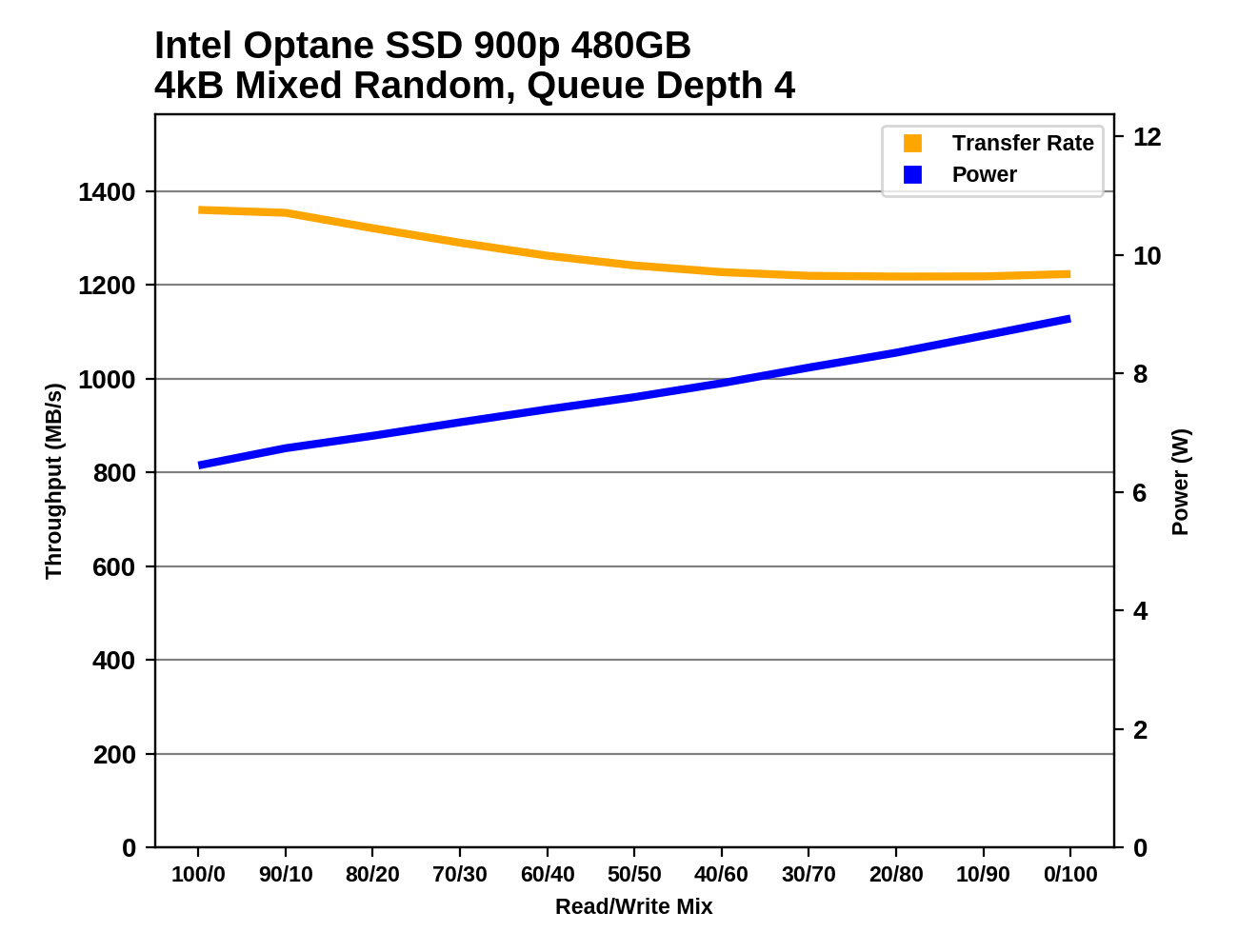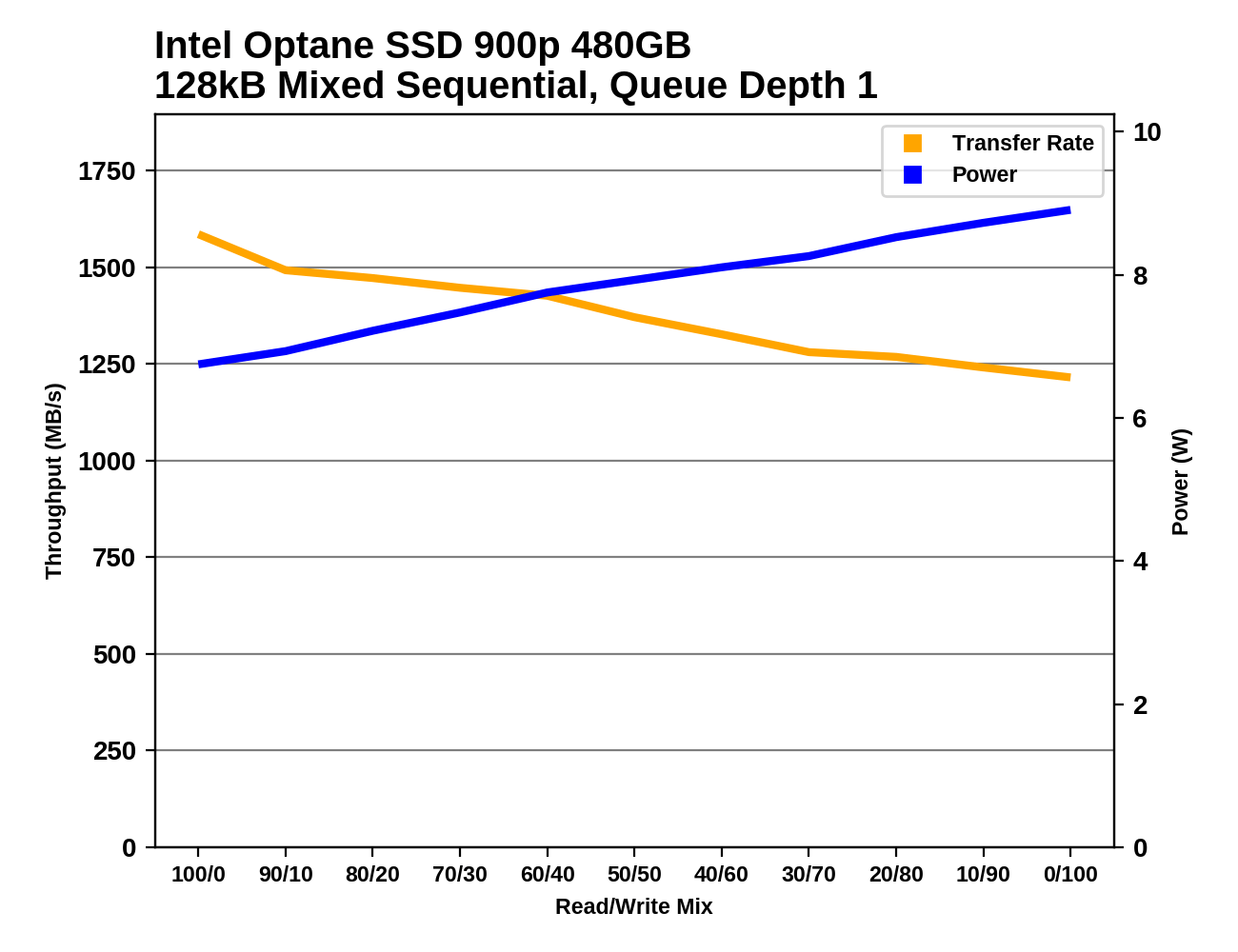The Intel Optane SSD 900p 480GB Review: Diving Deeper Into 3D XPoint
by Billy Tallis on December 15, 2017 12:15 PM ESTMixed Random Performance
Our test of mixed random reads and writes covers mixes varying from pure reads to pure writes at 10% increments. Each mix is tested for up to 1 minute or 32GB of data transferred. The test is conducted with a queue depth of 4, and is limited to a 64GB span of the drive. In between each mix, the drive is given idle time of up to one minute so that the overall duty cycle is 50%.

Since this mixed random I/O test is conducted at the relatively low queue depth of four, the Optane SSDs have a large performance advantage, and even the tiny Optane Memory M.2 does well (though it has to run a slightly modified version of the test due to its low capacity). The Optane SSDs are more than three times faster overall than the highest-scoring flash-based SSD.

The Optane SSDs have a substantial power efficiency lead on the mixed random I/O test, but it is small enough that flash-based SSDs could conceivably catch up with a generation or two of improvements. As usual, the 480GB model has clearly lower efficiency because its minor performance advantage doesn't outweigh the power cost the extra 3D XPoint memory chips.
 |
|||||||||
Both capacities of the Intel Optane SSD 900p show a modest decline in performance as the workload becomes more write-heavy, and a fairly linear increase in power consumption. The 480GB model's power consumption grows slightly faster than the 280GB model, leading to a 0.9W gap at the end of the test.
Even the Intel SSD 750 draws substantially less power for most of the test, though it catches up at the very end. The flash-based M.2 NVMe SSDs are mostly drawing a fraction of what the Optane SSDs require. In terms of performance, none of the flash-based SSDs come at all close to the Optane SSDs until the very end of the test, where many are able to deliver good random write speed.
Mixed Sequential Performance
Our test of mixed sequential reads and writes differs from the mixed random I/O test by performing 128kB sequential accesses rather than 4kB accesses at random locations, and the sequential test is conducted at queue depth 1. The range of mixes tested is the same, and the timing and limits on data transfers are also the same as above.

The Intel Optane SSD 900p is much faster on the mixed sequential I/O test than any consumer flash-based SSD. Samsung's best drives are slower by a third, and it's downhill from there for NAND flash. The 480GB model actually performed slightly worse on this test than the 280GB model, but the difference is small enough it may simply be due to variation between runs.

The power efficiency of the Optane SSD 900p on the mixed sequential I/O test is good but not quite at the top of the charts. Instead, it is on par with the Samsung 960 EVO, which sacrificed a bit of efficiency to improve performance relative to the Samsung 950 PRO.
 |
|||||||||
The 280GB Optane SSD 900p was a bit faster than the 480GB overall but a bit less steady over the course of the test. The scaling of the Optane SSDs is quite similar to the results from the mixed random test: a gradual decline in performance as the proportion of writes increases, and a linear increase in power consumption. The overall performance level is significantly higher than for the random I/O test.
The flash-based SSDs can get much closer to competing with the Optane SSDs on this mixed sequential test than on the mixed random test. Several drives have sequential read speeds that approach that of the Optane SSDs, and a few have higher sequential write performance. But through the middle portions of the test, the flash-based SSDs all lose a lot of their performance for at least a few phases of the test, while the Optane SSD has no acute performance weakness.










69 Comments
View All Comments
thestryker - Friday, December 15, 2017 - link
I'm curious if the power consumption on the u.2 version would be any different.Any chances of Intel hooking AnandTech up with a u.2 version? I know the storage bench system doesn't have u.2, but I'm sure there's a system around which does. I believe there's also a sku with m.2 to u.2 adapter also.
Billy Tallis - Friday, December 15, 2017 - link
The U.2 drive uses the same 12V supply as the add-in card, unlike SATA SSDs that use 5V. Any differences in power consumption would probably be minor variations due to different operating temperature.CheapSushi - Friday, December 15, 2017 - link
It's been so satisfying to see all the Optane haters, dismissers, general naysayers and "meh, ___ is good enuff" crowd, who pretend to be enthusiasts, finally backtracking on their comments about it. Good times.tricomp - Saturday, December 16, 2017 - link
Can't wait seeing my customer's jaws dropping... I build heavy multi-core workstations for 3D and post production. Using 480 jet like this for the OS is something they will truly appreciatemapesdhs - Monday, December 18, 2017 - link
Responsiveness, etc. with pro apps wasn't tested here. Where's the evidence it would be any better than a 960 Pro? I'd be more interested in a Puget Systems review with real world situations.tricomp - Monday, December 18, 2017 - link
I agree with mapesdhs. The main strength of this unit should be tested and compared, not to mention - mentioned - in an article called "deeper diving into 3D Xpoint"lilmoe - Saturday, December 16, 2017 - link
Pardon the ignorance, but is can XPoint memory packages run on lower voltages, or is operation dependent on a single constant voltage setting? Are there any plans for low-power based XPoint like LPDDR or DDRL? If so, I wonder how much performance and latency would degrade.As it is, these will never be able to compete with NAND in terms of power. Lots of users (like) me want this kind of power on the go. Samsung and others are simply NOT trying anymore. I've REALLY delayed purchasing a mobile workstation till these technologies get sorted out and it's clear for me what type of expansion I'll need for compatibility.
wanderer66 - Saturday, December 16, 2017 - link
There won't be mainstream memory modules until late next year, based on what I've read. I wouldn't count on seeing mobile workstation/laptop capability until 2019 or 2020, and that depends on several things: 2nd or 3rd gen optane modules using less power (due to die shrinkage), and a reference design from Intel that supports them on that kind of motherboard. Even then count on them consuming 10-15 watts for a loaded configuration.wanderer66 - Saturday, December 16, 2017 - link
Two things: This is first gen Optane architecture. *First Gen* sisters and brothers... In the next several years, performance will evolve as the controllers improve (greater parallelism and other performance tweaks), power usage will decrease as process optimization and die shrinkage improves, and the design moves beyond being able to use NVMe as the interface, which it will.Second, 550k iops. That's mind-blowing, really. This may not be hugely important to single-user workstations, but in the hosting/cloud markets, this is one of the largest leaps that can be made..
In five years time, Optane will be to flash SSDs what flash SSDs are to HDDs today.
djayjp - Sunday, December 17, 2017 - link
Would *really* like to see real world testing, not traces. In such tests no difference is ever apparent between the bargain basement SSDs and the absolute top tier, thus the current tests AT uses are nonsense.